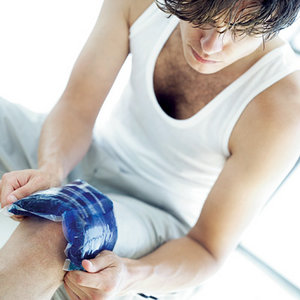Applying Ice Properly
 WHEN: Ice or gel packs are the first choice of care during the first 48-72 hours following injury.
WHEN: Ice or gel packs are the first choice of care during the first 48-72 hours following injury.
HOW: The application of ice directly to an injured or painful area of the body can be quite a shock at first. To avoid this, apply the ice pack as follows: Apply the ice, or gel pack over a towel which will allow for a gradual cooling and more comfort. Place the towel under hot (but not scalding) running water, wring out the excess water and place the towel on the affected area.
FREQUENCY: Each application of ice/gel packs should be 20-30 minutes, with 3-5 applications per day.
WARNINGS: Never apply ice for longer than 30 minutes at a time, and not at all if the injured party is suffering from any of the following: frostbite, areas of decreased sensation, Raynaud's disease, severe circulation problems, rheumatoid or gouty arthritis, or a worst-case scenario such as coma. Also do not use chemical ice bags that require shaking or have to be struck to be activated. Shaking and striking these bags may result in leakage of the active chemicals. The chemicals are usually caustic and may result in burns or other injuries.
Applying Heat Properly
 WHEN: Moist heat may be applied 48-72 hours after injury. Heat increases circulation by dilating blood vessels and letting more blood into the area.
WHEN: Moist heat may be applied 48-72 hours after injury. Heat increases circulation by dilating blood vessels and letting more blood into the area.
HOW: Moist heat provides more soothing relief than dry heat. Gel packs, hot towels, hot baths, hot showers, whirlpools, steam saunas, and moist heating pads are examples of heat with moisture.
FREQUENCY: Each application of moist heat should be 20-30 minutes, with 3-5 applications per day.
WARNINGS: Never apply moist heat for longer than 30 minutes. Never sleep on a heating pad.
 Gel Packs: Two Treatments in One
Gel Packs: Two Treatments in One
The most versatile piece of home therapy equipment you can own is a gel pack. Gel packs can be utilized for both cold and hot applications. Most are stored in the freezer until the need arises for cold application. If heat is needed, the pack can be transferred from the freezer to the microwave and heated as directed. Gel packs come in a variety of sizes and stay flexible at all temperatures. Constant flexibility allows the pack to be molded to the area of injury. Remember, it is always a good idea to place a towel between your skin and the gel pack.
Cut these instructions out and tape them on the inside of a medicine or kitchen cabinet so they will always be readily available whenever you or someone you know suffers a joint or muscle injury requiring first aid. Remember, the type, severity and circumstances surrounding the injury can impact the precise course of treatment to be pursued. For example, joint or bone deformity, uncontrollable bleeding associated with injury, loss of consciousness, loss of feeling in the area of injury, convulsions, etc., require immediate medical attention. Always consult with your doctor if you are unsure of the severity of an injury or if you have further questions regarding appropriate first-aid treatment.
K. Jeffrey Miller, DC, MBA,is an assistant professor of chiropractic at the University of Missouri Orthopedic Institute, a branch of the University of Missouri Health System. He is a graduate of Palmer College of Chiropractic and the author of several practitioner and patient texts.

